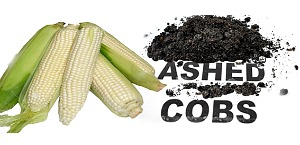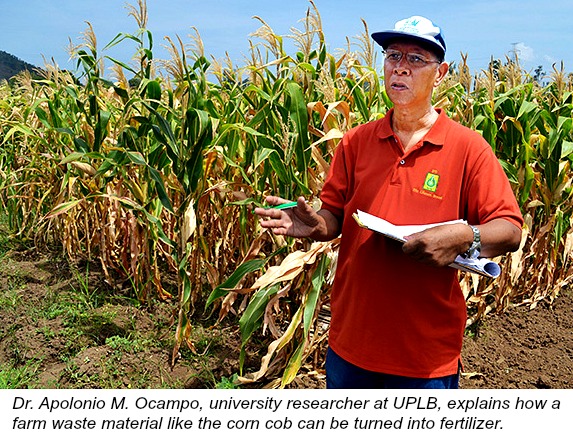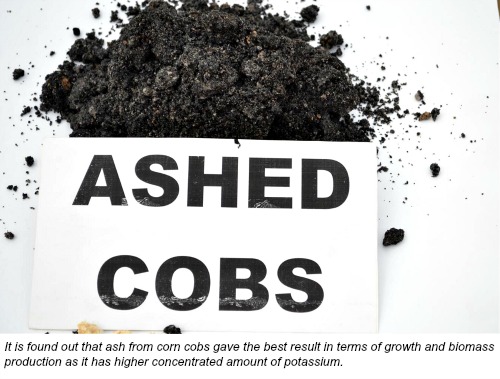 White corn is the choice staple food of about 14 million Filipinos next to rice, and yellow corn is used as a major feedstock for feeds. According to the data released by the Bureau of Agricultural Statistics (BAS), as of the first quarter of 2014, the country was able to produce 2.28 million metric tons (MT) of corn, a 1.33 percent higher than the last year production.
White corn is the choice staple food of about 14 million Filipinos next to rice, and yellow corn is used as a major feedstock for feeds. According to the data released by the Bureau of Agricultural Statistics (BAS), as of the first quarter of 2014, the country was able to produce 2.28 million metric tons (MT) of corn, a 1.33 percent higher than the last year production.
With that much production and only the corn kernels are utilized, imagine the wastage incurred to its inedible part – the corn cob.
Corn cob is part of the corn ear on which the kernels grow comprising of about 20-30 percent ear weight. In the Philippines, corn cobs are commonly utilized as fuel.
“May nag-suggest na gamitin na panggatong ang corn cobs. Pero kahit gamitin na fuel marami pa rin ang nakatambak na cobs sa mga processing plants at tumatambak din yung nakukuha nilang ash. So bakit di natin isipin ang ibang paggagamitan nito?” said Dr . Apolonio M. Ocampo, university researcher at the Crop Science Cluster, College of Agriculture, University of the Philippines Los Baños (UPLB).
There are sporadic cases noted wherein the corn cobs are used as fertilizer.
“Yung mga cobs na nakatambak ay nauulanan at nabababad. Merong ilang farmer na sinubukang kunin yung pinakatas o sabaw ng corn cobs at dinilig sa kanilang corn plantation at nakita nilang may magandang resulta,” he added.
As there are no scientific literatures to support the effectiveness of corn cobs as fertilizer, it cannot be officially recommended to the corn farmers to use their unutilized cobs as fertilizer, thus, a scientific research was initiated to explore the potential of the corn cobs as alternative source of potassium (K) fertilizer. This UPLB-led research is funded by the Bureau of Agricultural Research (BAR).
The project objectives are to: 1) identify and evaluate corn cultivars and the contribution of corn cobs in terms of available potassium and other nutrient contents; 2) evaluate the effectiveness of corn cobs and ashes derived from commercial corn dryers and farmer’s fields when used as K-source and determine the period of time required for the K to be available to plants when applied to the field; and 3) determine the economics of using corn cobs and/or ashes as substitute source for the potassium fertilization of white corn.
Four-season field fertilizer trials are done in UPLB experiment station and the two largest corn producing provinces: Isabela and Bukidnon. This is in collaboration with the Cagayan Valley Research Center (CVRC) and the Northern Mindanao Integrated Agricultural Research Center (NOMIARC).
Result of the study showed that using the corn cob rates of 0, 5, 10, 15 and 20 tons cobs per hectare (tons cobs/ha), the grain yield from commercially K-fertilized plots and plots that used corn cobs showed no significant difference.
“Sa nakita namin, maganda ang resulta. Maganda ang ani halos kapareha nung pagnilagyan mo ng inorganic potassium. Ang tinatagnan na lang namin ay kung gaano kadami ang natitira na potassium sa lupa pagkaraan ng apat na season or kada season. So yun ang ginagawa namin ngayon” explained Dr. Ocampo, project leader.
The study recommended that for white open pollinated variety (OPV) 10-15 tons cobs/ha should be used, while for hybrid corn, 20 tons cobs/ha is recommended to get a grain yield that is comparable to those of K-fertilized plots.
The study is also looking to determine which among the different corn cob sizes (whole, chopped, finely ground, and ash) are most effective in releasing potassium to be used by the plants. It is found out that ash from corn cobs gave the best result in terms of growth and biomass production as it has higher concentrated amount of potassium. Corn cobs have potassium content averaging one percent while the ash form has a potassium content ranges from 21 – 33 percent.
“Mas magandang gamitin ang ash kasi ang ibigsabihin nun ay mas konti ang ilalagay mo sa lupa kumpara sa cobs. Pero ang cobs naman kasi ay puwedeng gamitin ng mga farmers na walang access sa processing plant or drier or magpa-process into ash nung cobs” Dr. Ocampo added.
The use of cobs or the ash depends also on the resources within the area concerned.
Based on the analysis done, the K fertilizer requirement differs from one area to another. Corn fertilization using 2 bags of muriate of potash (0-0-60) is equivalent to 5.5 bags ash or 104 bags of cobs in Bukidnon, 3.6 bags ash (83 bags cobs) in Isabela, 4.2 bags ash (111 bags cobs) at CVRC, Isabela, and 4.2 bags ash (49.2 bags cobs) at Institute of Plant Breeding, UPLB.
From the farmer’s perspective, a corn farmer in Mindanao averaging a harvest of 6-8 tons/ha can get a 1.2 – 3 tons of cobs. Though not enough to cover the K-fertilization of a hectare corn farm, it can still help decrease the production cost of farmers as muriate of potash when commercially purchase cost is around Php 1,800. Also, the application is easier as the farmer have to only scatter in his corn field the corn cobs or ash during the land preparation.
The farmers can also use the corn cobs extracts as foliar spray or liquid fertilizer by soaking it for four to five weeks in water. However, the proponents are still determining the right amount of dilution for optimum effectiveness.
With fertilizers getting a huge chunk of the production cost, farmers must have options for cheaper alternatives while still maintaining or better yet, increasing their profits. Research such as this, wherein a supposedly farm waste or crop residue can still be converted into something functional is an important step towards a sustainable practice of agriculture.
Source: Diana Rose A. de Leon (The Philippine Star); www.bar.gov.ph

